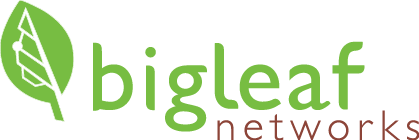TruHome Goes All-In on Cloud Telephony with Bigleaf SD-WAN as the Foundation
Customer Profile
Founded in 2004, TruHome provides a full range of private-label services to credit unions nationwide to grow their mortgage offerings. With its expertise, technology solutions, and member-centric focus, TruHome leverages the power of collaboration that already exists in the credit union industry to process full-service originations and everything else necessary in the lifecycle of a mortgage.
Moving to a Cloud-based telephony solution
The company began as a business unit of a larger company, relying on their IT infrastructure and self-hosted telephony solution. As TruHome matured and grew to operate autonomously, it had a critical need to institutionalize itself as a fully standalone enterprise and that meant building out its own back-office functions. It needed its own telephony solution, not something managed and controlled through chargebacks to the mothership.
“From its start, TruHome had a cloud-first mentality. So it was natural we wanted to go all in on software-defined and cloud-delivered telephony like UCaaS and have someone else shoulder the burden of infrastructure,” John Pentlin, vice president of IT at TruHome, explains. “Maintaining a focus on UCaaS from the get-go meant we could build a system that decoupled us from on-premise and geographic carrier-based circuits.”
But first, Pentlin had to convince the company’s leadership team on his approach. The company’s leaders knew they had a single point of failure in their phone system. If the phones were down, their call centers weren’t operating. They wanted to know how moving to the cloud would solve that problem.
“Our business leaders had call center backgrounds, so they understand both the importance and the challenges of telephony,” said Pentlin. “Half of our employees operate out of two call centers. Telephony is important to us because these aren’t just standard office workers working on phones.”
Building their new voice system on a solid network foundation
Pentlin knew that even the best telephony software would not operate well if a solid network foundation wasn’t in place. He and his team looked to SD-WAN to accelerate the decoupling from the mothership but quickly discovered that not all SD-WAN vendors adhere to the definition of the technology itself.
TruHome started down the path with one SD-WAN vendor it thought would be the safe bet to provide the call quality the company required. Pentlin liked the vendor’s proposed delivery methodology. But the rollout ran into a brick wall when the vendor’s technology didn’t live up to their sales pitch. After talking with the SD-WAN vendor’s engineering, it became clear that they had oversold the ease of the insertion topology and couldn’t provide the high availability that Pentlin was looking for.
The vendor couldn’t facilitate TruHome’s solution the way Pentlin wanted without blowing up their cost model. What’s more, the vendor’s topology would’ve forced TruHome to over design its edge network, couldn’t provide proper high availability and introduced a single point of failure into the network.
“It’s one thing to run your data applications on ISP circuits and your telephony on a standard carrier,” Pentlin explained. “If one’s down, that’s not a big deal. But when you have all your eggs in one basket running data and telephony over the same line, that means you have to up the ante on your edge and data circuits. It means you need a topology that allows you to leverage multiple carriers and solves every outage solution you can throw at it, not just the ones you think to write policies for.”
Deciding to go with Bigleaf’s cloud-first SD-WAN
TruHome pulled the plug on the initial vendor and began looking for a new partner who could deliver on the promise of SD-WAN.
“We found vendors have various definitions of SD-WAN, some well-defined and some not,” lamented Pentlin. “When you peel away the onion, you find some are just WAN ops in disguise and not true SD-WAN. And when you’re architecting a fully software-defined telephony solution, you want to run it over the Internet, not provision each location with its own T1 or T3 line. You want the SDN at the edge to allow for carrier diversity and high resiliency.”
With the company’s migration to its UCaaS provider, bearing down, the vendor recommended Pentlin take a look at Bigleaf’s cloud-first SD-WAN. Lightbulbs started going off once Pentlin saw Bigleaf. “We looked at a dozen other SD-WAN providers. When we saw Bigleaf it was a no-brainer.”
While checking off all the foundational boxes TruHome needed from its SD-WAN, Bigleaf’s firewall transparency and insertion topology solved many other challenges for TruHome.
“We have a couple of members of the team who speak SD-WAN’s language and weren’t averse to trying to build and deploy a custom solution. But if we don’t have to, why would we? Bigleaf was virtually plug-and play. As a former network engineer, moving to Bigleaf was a home run.”
Pentlin knew his way around a command line but understood his time and experience was more valuable solving more vexing technology issues for the business. He also knew that carrying a full-time network engineer or expecting that level of expertise from his internal team was unrealistic.
“We couldn’t have asked for a simpler solution,” Pentlin said. “Bigleaf’s design meant it was purely at the edge, abstracted and outside the firewall. It’s automation and ability to let artificial intelligence do what old policy-based solutions try to do, translates into huge time savings because I no longer have to intervene at the network layer on a daily basis.”
As the team started to peel the Bigleaf onion, they found that Bigleaf’s insertion topology solved all of its problems.
“At each step of the deployment, Bigleaf solved every roadblock we ran into with that original vendor,” Pentlin said.
Bigleaf provides the network topology TruHome needs
Bigleaf’s unique Site-to-Cloud Architecture links TruHome’s call centers to the backbone of the Internet. So they’re always within a few hops from any cloud technology that they decide to use. The company’s intelligent software creates a resilient and high-performance connection utilizing readily available Internet connections anywhere that TruHome does business. Bigleaf’s Dynamic QoS feature automatically detects and prioritizes their most critical Cloud application traffic. The Intelligent Load Balancing feature ensures that those priority applications are routed over the ISP that will provide the best end-user experience. These autonomous decisions are made and implemented 10 times per second, ensuring uninterrupted application performance.
“With our original vendor, we were constantly trying to translate our network requirements in intimate detail to a third party. We’re mean and lean. We don’t have a full-time network engineer on staff. Using Bigleaf meant we could roll it out it all on our own.”
Bigleaf meant TruHome could deploy quickly without redesigning its network or making routing decisions that the Bigleaf software could intelligently do for it.
“Bigleaf was extremely straightforward to implement into the network. The insertion topology completely met our criteria,” said Marc Cote, TruHome’s Cloud Systems Engineer. “Their staff gathered our ISP information, the equipment was delivered preconfigured ready to plug in, cable up, and run.”
With Bigleaf, TruHome’s IT team can focus on what it does best
Today, more than 200 TruHome employees operate behind two 100mb circuits with tier 1 carriers in the company’s call center. Pentlin says the company’s network is operating more efficiently now that Bigleaf’s router is shepherding its traffic. “Bigleaf works behind the scenes to allow our people to do their jobs. They’ve seen no downtime to date and more resiliency in an area of the business they are not accustomed to seeing uptime and resiliency.”
Pentlin also found that the real-time visibility Bigleaf gives him through its web dashboard is a way to catch carrier issues before they become a problem. This multi-tenant web dashboard provides TruHome the visibility needed to troubleshoot WAN or Internet issues, evaluate bandwidth/speed adjustments, and understand the impact of network performance on application experience. This data includes statistics, graphs, and events about the performance of Bigleaf services and ISP connections.
“One of the great things about Bigleaf is that, by design, it makes sure carrier issues don’t impact our business. It programmatically and intelligently monitors each of your Internet connections 10 times per second, understands which connection is providing the better service and utilizes the best one. But if you’re not paying attention to your carriers, they have the ability to get away from you. Nobody wants to call their carrier to hassle with them over outages or quality of service. Bigleaf saves us time that can be better spent doing the things we do best.
Bigleaf has become business as usual for TruHome. It’s saved the company from carrier outage downtime and saved Pentlin’s team from having to work after hours.
“It’s out of sight and out of mind, which, as an IT manager, is how I wish all technology would operate. Bigleaf allows us to focus on the things we need to focus on.”
Bigleaf gave TruHome the solid foundation it needed to become the autonomous company it set out to be.
If your business needs help building a rock solid cloud first network, please give us a call. We can make it simple.

